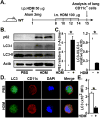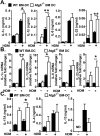Lack of autophagy induces steroid-resistant airway inflammation
- PMID: 26589586
- PMCID: PMC4860134
- DOI: 10.1016/j.jaci.2015.09.033
Lack of autophagy induces steroid-resistant airway inflammation
Abstract
Background: Neutrophilic corticosteroid-resistant asthma accounts for a significant proportion of asthma; however, little is known about the mechanisms that underlie the pathogenesis of the disease.
Objective: We sought to address the role of autophagy in lung inflammation and the pathogenesis of corticosteroid-resistant neutrophilic asthma.
Methods: We developed CD11c-specific autophagy-related gene 5 (Atg5)(-/-) mice and used several murine models to investigate the role of autophagy in asthmatic patients.
Results: For the first time, we found that deletion of the Atg5 gene specifically in CD11c(+) cells, which leads to impairment of the autophagy pathway, causes unprovoked spontaneous airway hyperreactivity and severe neutrophilic lung inflammation in mice. We found that severe lung inflammation impairs the autophagy pathway, particularly in pulmonary CD11c(+) cells in wild-type mice. We further found that adoptive transfer of Atg5(-/-), but not wild-type, bone marrow-derived dendritic cells augments lung inflammation with increased IL-17A levels in the lungs. Our data indicate that neutrophilic asthma in Atg5(-/-) mice is glucocorticoid resistant and IL-17A dependent.
Conclusion: Our results suggest that lack of autophagy in pulmonary CD11c(+) cells induces neutrophilic airway inflammation and hyperreactivity.
Keywords: Autophagy; asthma; corticosteroid-resistance asthma; lung inflammation; neutrophilic asthma.
Copyright © 2015 American Academy of Allergy, Asthma & Immunology. Published by Elsevier Inc. All rights reserved.
Conflict of interest statement
The authors have declared that no conflict of interest exists.
Figures






Comment in
-
Reply.J Allergy Clin Immunol. 2017 Feb;139(2):712-713. doi: 10.1016/j.jaci.2016.06.067. Epub 2016 Nov 12. J Allergy Clin Immunol. 2017. PMID: 27847142 No abstract available.
-
A possible differential role of autophagy in asthma?J Allergy Clin Immunol. 2017 Feb;139(2):712. doi: 10.1016/j.jaci.2016.07.046. Epub 2016 Nov 12. J Allergy Clin Immunol. 2017. PMID: 27847143 No abstract available.
References
-
- Wills-Karp M. Immunologic basis of antigen-induced airway hyperresponsiveness. Annu Rev Immunol. 1999;17:255–81. - PubMed
-
- Lambrecht BN, Hammad H. The airway epithelium in asthma. Nat Med. 2012;18:684–92. - PubMed
-
- Chung KF, Godard P, Adelroth E, Ayres J, Barnes N, Barnes P, et al. Difficult/therapy-resistant asthma: the need for an integrated approach to define clinical phenotypes, evaluate risk factors, understand pathophysiology and find novel therapies. ERS Task Force on Difficult/Therapy-Resistant Asthma. European Respiratory Society Eur Respir J. 1999;13:1198–208. - PubMed
-
- ATS. Proceedings of the ATS workshop on refractory asthma: current understanding, recommendations, and unanswered questions. American Thoracic Society. Am J Respir Crit Care Med. 2000;162:2341–51. - PubMed
Publication types
MeSH terms
Substances
Grants and funding
LinkOut - more resources
Full Text Sources
Other Literature Sources
Medical
Research Materials

